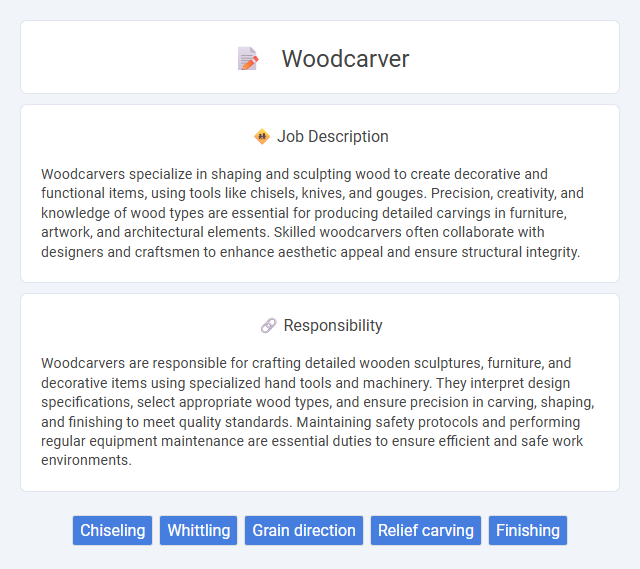
Woodcarvers specialize in shaping and sculpting wood to create decorative and functional items, using tools like chisels, knives, and gouges. Precision, creativity, and knowledge of wood types are essential for producing detailed carvings in furniture, artwork, and architectural elements. Skilled woodcarvers often collaborate with designers and craftsmen to enhance aesthetic appeal and ensure structural integrity.
Woodcarving may appeal to individuals who possess strong manual dexterity, patience, and an eye for detail, suggesting a higher probability of suitability for people with steady hands and creative tendencies. Those who find prolonged focus challenging or prefer fast-paced environments might struggle with the repetitive and meticulous nature of the work. Physical stamina and the ability to work with various tools safely could also influence the likelihood of success in this profession.
Qualification
Woodcarvers require proficiency in woodworking tools, hand carving techniques, and a strong understanding of wood types and grain patterns. Formal training from vocational schools or apprenticeships enhances skills in precision, design interpretation, and safety practices. Experience in creating detailed sculptures or functional wood items is essential for mastering the craft and meeting industry standards.
Responsibility
Woodcarvers are responsible for crafting detailed wooden sculptures, furniture, and decorative items using specialized hand tools and machinery. They interpret design specifications, select appropriate wood types, and ensure precision in carving, shaping, and finishing to meet quality standards. Maintaining safety protocols and performing regular equipment maintenance are essential duties to ensure efficient and safe work environments.
Benefit
Woodcarvers likely enjoy the benefit of transforming raw materials into unique, customized art pieces or functional items, offering a satisfying creative outlet. They probably experience the advantage of flexible work environments, often operating independently or in small workshops. Income potential and job satisfaction may increase with skill development and reputation in specialized woodcraft markets.
Challenge
Woodcarving may present challenges such as mastering precision and attention to detail, which are likely essential for creating intricate designs. The likelihood of facing physical strain from prolonged use of hand tools could be significant. Overcoming these difficulties probably requires patience and continuous skill development.
Career Advancement
Woodcarvers gain career advancement by mastering advanced carving techniques, specializing in niches such as furniture design or sculpture, and building a strong portfolio to attract high-profile clients. Professional certification and participation in trade organizations can enhance credibility and open opportunities for teaching or leading workshops. Experienced woodcarvers may also advance by establishing their own studios or collaborating on large-scale architectural projects.
Key Terms
Chiseling
Woodcarvers specialize in chiseling wood to create detailed designs, sculptures, and functional objects, using a variety of chisels tailored for precise cuts and intricate patterns. Mastery of chiseling techniques ensures clean edges, smooth finishes, and the ability to bring out natural wood grain textures, enhancing the aesthetic quality of the final piece. Expertise in wood types, grain direction, and appropriate chiseling pressure is essential for efficient material removal and minimizing wood splintering.
Whittling
Woodcarvers skilled in whittling transform blocks of wood into intricate shapes using specialized knives and tools, emphasizing precision and attention to detail. This craft demands a deep understanding of wood grain, carving techniques, and safety practices to produce artistic or functional items. Expertise in selecting appropriate wood types, such as basswood or butternut, enhances the quality and durability of whittled creations.
Grain direction
Woodcarvers must carefully consider the grain direction of the wood to ensure smooth cuts and prevent splitting or cracking. Aligning tools with the natural grain enhances control and precision, producing detailed and durable carvings. Understanding grain patterns also helps in selecting the best wood type for each project, optimizing both aesthetics and structural integrity.
Relief carving
Relief carving is a specialized form of woodcarving that involves shaping figures and patterns that project slightly from a flat background, creating a three-dimensional effect. Skilled woodcarvers use chisels, gouges, and knives to achieve detailed textures and depth, often working on decorative panels, furniture, or artwork. Mastery of relief carving requires a keen understanding of wood grain, depth perception, and artistic composition to transform flat surfaces into intricate designs.
Finishing
Woodcarvers specialize in refining wooden sculptures or furniture by sanding, staining, and varnishing surfaces to enhance texture and durability. Expert finishing techniques involve applying sealants and polishing to protect the wood from moisture and wear. Mastery of finishing tools and materials ensures that the final product achieves a smooth, aesthetically pleasing appearance with lasting quality.
 kuljobs.com
kuljobs.com